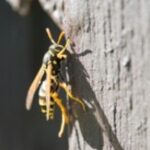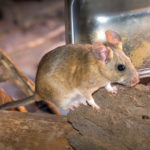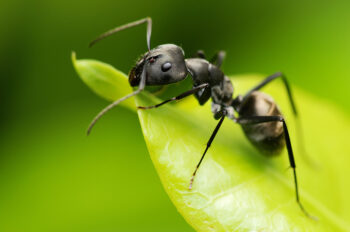
Insecticide resistance is a reduction in the ability of an insecticide in achieving the desired control.
This is reflected in the repeated failure of an insecticide’s expected level of control of insects when used according to the product label recommendations and where causes have been eliminated. There are several ways insects can become resistant to the products:
Behavioral resistance:
Resistant insects may detect or recognize danger and avoid the toxin. This mechanism of resistance has been reported for several classes of insecticides, including organochlorines, organophosphates, carbamates (none of which we will use), and pyrethroids. Insects may simply stop feeding if they come across certain insecticides, or leave the area where spraying occurred. Maxforce has had to change the formulation several times in the last two decades for this reason.
Penetration resistance:
Resistant insects may absorb the toxin more slowly than susceptible insects. Penetration resistance occurs when the insect’s outer cuticle develops barriers that can slow the absorption of the chemicals into their bodies. This can protect insects from a wide range of insecticides. Penetration resistance is frequently present along with other forms of resistance, and reduced penetration intensifies the effects of those other mechanisms. This is currently happening with bed bugs and the use of pyrethroids.
Metabolic resistance:
Resistant insects may detoxify or destroy the toxin faster than susceptible insects, or quickly rid their bodies of the toxic molecules. Metabolic resistance is the most common mechanism and often presents the greatest challenge. Insects use their internal enzyme systems to break down insecticides. Resistant strains may possess higher levels or more efficient forms of these enzymes. In addition to being more efficient, these enzyme systems also may have a broad spectrum of activity (i.e., they can degrade many different insecticides). Cockroaches are known to be able to metabolize pyrethrin when a synergist is not present.
Altered target-site resistance. The site where the toxin usually binds in the insect becomes modified to reduce the insecticide’s effects. This is the second most common mechanism of resistance.
What Can You Do About Insecticide Resistance?
The best strategy to avoid insecticide resistance is prevention. More and more pest management specialists recommend insecticide resistance management programs as one part of a larger integrated pest management (IPM) approach. The old school of rotating family of products is one example. This means do not us the same product or family group for more than three consecutive months.
- Monitor pests. Scouting is one of the key activities in the implementation of an insecticide resistance management strategy. Monitor insect population development in fields with the assistance of a consultant or advisor if necessary to determine if and when control measures are warranted. Monitor and consider natural enemies when making control decisions in some cases. Use mechanical means to reduce pest populations (vacuum or exclusion). Environmental changes such as water reduction and food sources will reduce the overall pest population. After treatment, continue monitoring to assess pest populations and their control.
- Focus on economic thresholds. Insecticides should be used only if insects are numerous enough to cause economic losses that exceed the cost of the insecticide plus application. Remember that the economic thresholds in the urban environment vary. In hospital settings, the economic or tolerance it should be zero. Consult local advisors about economic or tolerance thresholds for target pests in your area.
- Take an integrated approach to managing pests. Use as many different control measures as possible. Effective IPM-based programs will include the use of synthetic insecticides, biological insecticides, beneficial arthropods (predators and parasites), cultural practices, mechanical or environmental changes, and chemical attractants or deterrents. Select insecticides with care and consider the impact on future pest populations and the environment. Avoid broad-spectrum insecticides when a narrow-spectrum or more specific insecticide will work.
- Time applications correctly. Apply insecticides when the pests are most vulnerable. For many insects, this may be when they have just emerged. Use application rates and intervals recommended by the manufacturer or a local pest management expert (i.e., university insect management specialist, county Extension agent, or consultant).
- Mix and apply carefully. As the potential for resistance increases, the accuracy of insecticide applications in terms of dose, timing, coverage, etc. assumes greater importance. The pH of water used to dilute some insecticides in tank mixes may need to be adjusted to the product manufacturer’s specifications. Sprayer nozzles should be checked for blockage and wear, and should be able to handle pressure adequate for good coverage. Spray equipment should be properly calibrated and checked on a regular basis. Use application volumes and techniques recommended by the manufacturers and local advisors.
- Alternate different insecticide classes. Avoid the repeated use of the same insecticide or insecticides in the same chemical class, which can lead to resistance and/or cross-resistance (1). Rotate insecticides across all available classes to slow resistance development. In addition, do not tank-mix products from the same insecticide class. Rotate insecticide classes and modes of action, consider the impact of pesticides on beneficial insects, and use products at labeled rates and spray intervals.
- Protect beneficial arthropods. Select insecticides in a manner that is the least damaging to populations of beneficial arthropods. For example, apply insecticides in cracks and crevices instead of a spot treatment.
How Do You Properly Alternate Insecticides to Avoid or Delay Resistance?
Effective insecticide and miticide resistance management (IRM) strategies seek to minimize the selection for resistance from any one type of insecticide or miticide. In practice, alternations, sequences or rotations of compounds from groups with different modes of action can provide a sustainable and effective approach to IRM (i.e., where resistance results from altered target sites in the insect). This ensures that selection from compounds in the same mode-of-action group is minimized. Applications are often arranged into mode-of-action spray windows or blocks that are defined by the stage of the biology of the pest(s) of concern. Follow local expert advice with regard to spray windows and timings. Several sprays of a compound may be possible within each spray window but it is generally essential to ensure that successive generations of the pest are not treated with compounds from the same mode-of-action group. It is the aim to make insecticide and miticide users aware of mode-of-action groups and to have a sound basis on which to implement season-long, sustainable resistance management through the effective use of sequences of insecticides with different modes of action. To delay resistance, clients should also integrate other control methods into insect or mite control programs. For more information on insecticide resistance management, contact your local county Extension agent, Land-grant University, insect management specialist, or the Insecticide Resistance Action Committee website at: http://www.irac-online.org
This publication was adapted from the Insecticide Resistance Action Committee (IRAC) in cooperation with the Southern Region Integrated Pest Management Center. I found it important to change it to reflect Urban Pest Management’s needs. I also provide the link to IRAC for further information. By Ralph H Maestre BCE





